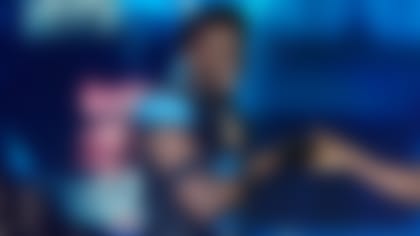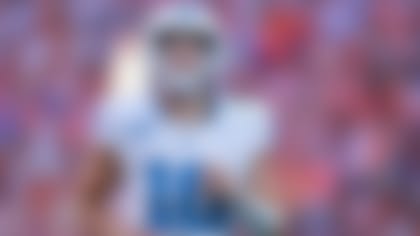He doesn't love football. He isn't willing to play through pain. He milked his back injuries.
He was stealing money from the Philadelphia Eagles.
Shawn Andrews has heard all of this firsthand, whether on talk radio, through the grapevine or, at times, even in his own locker room in Philly. This became his unsightly brand in league circles and even now, as the former Pro Bowl tackle progresses in his comeback with the New York Giants, the whispers haven't really subsided.
Andrews dealt with one of the more inconvenient sets of issues an NFL player can encounter, a series of severe, difficult-to-assess and alternating back maladies that put his career in jeopardy at the same time he was also diagnosed with depression. In a league where so many crimes and transgressions are overlooked, Andrews bore the dual stains of being consistently injured (What good are you if you can't play on Sunday?) and being mentally unstable (in pro sports, oftentimes, anything not easily understood is feared or shunned).
Few NFL players have dealt publicly with depression, as Andrews has, and equally as few have returned from two major back injuries to reclaim their career amid the ceaseless collisions of the offensive line. The former stalwart is currently taking reserve reps with the Giants' guards and tackles after signing a potentially lucrative deal with the team on Aug. 20.
After essentially two lost years and fighting through an ominous cloud of surgery, rehab and recovery, Andrews feels better than ever, and, at 27, he could prove to be one of the most prescient acquisitions this offseason, despite signing so late and under the radar.
"I think without a doubt he wants to play football," Giants GM Jerry Reese said. "Why else would you put yourself through the rigors of staying in hotels and working out all those hours and doing those things it takes to try to make a comeback? And the thing about it is, everybody at some point in life has some life issues they have to go through. And so he went through some things, and I feel like he's in a very good place right now, and he convinced us he's in a very good place and feels good about where he is.
"He knows the contract is structured for him to earn the money, and if he's willing to do this right there's plenty of money to be made. But he knows he has to come in and show he's ready to do it, and he's healthy enough to do it, and time will tell."
Far too few people know or understand precisely what Andrews has overcome. While the scorn and ridicule has played out in public, with the number of missed games and character questions mounting, the truth about all that ailed Andrews -- a discovery and recovery on mental and physical pain -- was achieved entirely in private.
It came through speaking with mental health professionals and, for a while, taking antidepressants. It was unearthed gradually at doctor's offices around the country, as Andrews finally learned that his most recent back issues stemmed from an injury first suffered eight years ago in high school. It was remedied twice on a surgical table in Los Angeles. And from September 2009 through August 2010, at a nondescript rehabilitation facility in Culver City, Calif., Andrews made incremental gains through his work with rehab specialist Heather Milligan, recovering to the point where the Giants offered him a six-year deal that could be worth as much as $40 million.
-- Shawn Andrews
"I've brought quite a few question marks upon myself, and I know that," Andrews said following his preseason debut over the weekend. "But the guys in the front office here were willing to follow me for a long time and keep checking in with me. They analyzed what they could see on film and came to California to see me work out, and they could tell through my play and how I am that I still have a passion for the game.
"Take away the depression, because I have overcome that, and, yes, I still have some back issues. But I am so grateful they had enough confidence in me to watch how I've come along, and they were right there the whole time. It's tough to describe the feeling of playing again. I almost feel like it's the first game of my rookie year, being that excited. It's a powerful feeling."
For someone who allegedly didn't care about football, or wasn't willing to fight through pain, Andrews sure had a funny way of showing it. He asked for multiple opinions at the Eagles' behest and lived in a hotel in Culver City for 11 months to be within walking distance of his rehab facility, enduring days filled with pain and occasional doubt.
Problems arise
Despite the back issue, Andrews was an All-American at Arkansas and was selected by the Eagles with the 16th pick in the 2004 draft. He was thoroughly evaluated at the combine and beyond and was able to play. Andrews experienced a gruesome injury during his rookie year, breaking his fibula in the season opener and not returning until early in 2005 to play all 16 games and become a Pro Bowl alternate. He battled weight issues (400 pounds in college; 365 as a rookie; down to 335-340 in 2006 after altering his diet and working with a dietician in San Diego) and performed well enough that in June 2006 he earned a contract extension thru 2015 that included a $10 million signing bonus.
Andrews was voted a Pro Bowl starter for the 2006 season, but against the Saints in the playoffs he was pulled at halftime with his neck badly swollen and eyes blood shot. He was rushed to the hospital in an ambulance and was held out of the Pro Bowl by the Eagles. In 2007, Andrews played at an All-Pro level, thriving in the years immediately after his extension.
The 2008 season was significantly more troublesome. He departed the Eagles in June, then failed to report for training camp without an excuse. When Andrews informed his agent, Rich Moran, that he wouldn't be reporting, Moran conferred with coach Andy Reid before flying to Andrews' home in Little Rock to try to find him a doctor to speak with.
"He was instrumental in helping me along," Andrews said of Reid.
The Eagles sheltered Andrews' issues from the press until the player was eventually ready to talk about his diagnosis of depression. The organization displayed great patience, issuing no fines and showing compassion that had been lacking from fans and the media, where Andrews would be criticized for skipping work and/or feigning the condition.
Andrews says now he wishes he would have handled the depression better. He felt angry at times, which he could not explain, and had difficulty doing normal things. He would tell his teammates he didn't want to go to camp. He alternated the colors of his faux-hawk haircut and dabbled with music and was seen as eccentric to some, which made him an easier target for ridicule. Through his treatment he realized he had been harboring some of these symptoms for years, was prescribed the antidepressant Wellbutrin for eight months (he is no longer on it) and reconnected with his spiritual side.
"The depression thing, it's kind of almost like frustrating when people say I diagnosed myself," Andrews said. "I didn't diagnose myself. Along the way I never understood what depression was, and I had always internalized things. I'd put on a face and be a silly guy, and I love to have fun, but that's also a mask for me, and unfortunately it's going to break. I'd rather it not have happened in the public eye, but I've been fighting it and I have great support.
"The life-changing point for me came when I first sat down with the first doctor I saw in Little Rock. Despite all the bad press and all the rumors and even the stuff I heard from my teammates and the people I worked with, once the doctor told me to tell him everything from the start to finish, my healing process began. ... Now I don't have any of those bad thoughts in my mind anymore. I'm loving my second and third chance at this football thing."
Andrews returned for the start of the 2008 regular season -- missing 17 days of camp in all -- and turned in three halves of dominant football. He showed no signs of depression on the field, mauling the Cowboys in Week 2, but was triple teamed on a field goal attempt late in the first half, which would result in his first back surgery that ultimately would be the cause for his departure from Philadelphia.
Rehab while being doubted
Team medical personnel would not allow Andrews back on the field for the second half of the Cowboys game. After epidural shots provided no relief, the Eagles sent Andrews to one doctor after the next. Ultimately, noted surgeon Dr. Robert Watkins conducted the procedure. He showed Andrews and Moran MRIs which revealed his old high school injury in the L5/S1 region -- which was minor and had not limited his play to that point -- and determined the pain was being caused by a different area. A microdiscectomy (spine surgery) was performed on his L4/L5 region in October to remove fragments.
"His condition was absolutely real from the first time I saw him," said Watkins, who has been operating on pro athletes since 1980. "The weakness he was experiencing then in his leg matched the exact nerve that the disc rupture was pressing on. Shawn had an excellent rehab and was able to walk back on the field for preseason camp."
The Eagles projected a recovery of up to three months, and they left a roster spot open for Andrews in hopes of his return; had they reached the Super Bowl he would have been cleared to take part, but they lost the NFC Championship Game to Arizona. Andrews went through the entire 2009 offseason program at right tackle -- the Eagles signed his brother, Stacy, from the Bengals and were moving Shawn to guard -- but during a training camp conditioning test, he began feeling some discomfort.
The team sent Andrews back to Dr. Watkins, who, like the Eagles, felt that some of the problems could be due to the recent surgery. Andrews returned to practice ahead of the opening game, but the pain persisted, and with no solution in sight and a second surgery a possibility, the Eagles put Andrews on IR after Week 1 of the 2009 season.
"He just hasn't made progress with the rehab," Reid said at the time. "And it's not from lack of effort on his part. He's been very diligent, working hard. From all the reports we get, he's working his tail off. He's just not getting better."
The Eagles did not require Andrews to work out near them; they actually urged him to go elsewhere, generally a strong indication a player is no longer in a team's plans. Team trainer Rick Burkholder, held in his esteem by Andrews and Moran, recommended that Andrews work with Milligan at Select Physical Therapy in Culver City (that facility has ties to the Eagles' NovaCare facility in Philadelphia and is close to Watkins' office).
Andrews spent three months rehabbing in Los Angeles, as doubts about the severity and nature of the injury mounted. Though Reid stood by the player, the media took aim as teammates questioned Andrews. It was generally assumed around the league that Andrews was dogging it, a perception he understands was fostered by some of his bizarre tweets and YouTube postings.
Still, Andrews spent hours every day with Milligan, and she was distressed by a lack of progress. All this time it has been assumed the numbness and pain was likely stemming, at least to some degree, from the 2008 injury. But Milligan persisted, knowing that enough time has passed post-surgery where that should have subsided. As she gave Andrews "muscle tests," despite her slight 5-foot-3 frame, he could not provide adequate resistance as she manipulated his legs and knees, and the pain in his back was acute.
"That weakness is not something you can pretend or fake," Milligan said, "especially when you look at someone of his size. For me at my size to be able to muscle test him and actually break him, there was something going on."
'Hell, yeah, I want to play'
So last November she asked Dr. Watkins to look at Andrews again and, seeking more information, Watkins ordered a discogram (X-ray). Andrews flew to Dallas, with Milligan, where spine specialist Dr. Drew Dossett inserted a needle into each disc, gradually increasing pressure to determine the origins of the pain.
-- Dr. Robert Watkins on Andrews
"When the needle was inserted to L5/S1 (where the high school injury occurred), there was no doubt that's where the pain was coming from," said Milligan, who was in the room during the procedure.
Dr. Dossett told Andrews that he should undergo another surgery only if he wanted to play football again.
"I said, 'Hell, yeah, I want to play," Andrews said. "Having that second surgery alone should have sent a signal to the league, but I was away from the game and people didn't have a feel for that, so everyone kept questioning me."
In December, Dr. Watkins once again operated on Andrews, this time doing very minor work in the location of his first surgery (L4/L5), but concentrating primarily on L5/S1, and the issues with a nerve there that extends to the foot and can prevent a lineman from getting on his toes in pass protection.
"Shawn was right on from Day 1 in terms of what he was experiencing," Watkins said. "He's kind of a low-key guy, and he's very strong and he always gave me the symptoms exactly the way they were and was very straight forward about it. When he said he couldn't go, he really couldn't go.
"It would have been easy to say after the first surgery that he's got a disc degeneration, and there's nothing we can do. But he was such a reliable historian about his back, and he worked so hard in his rehab program. And when we went back for the second surgery and looked at that original L5/S1 protrusion it definitely looked bigger, and we took out a big centralized fragment that was lower than before."
Second chance with a former foe
Watkins told Andrews and the team the recovery was likely to take at least six months, and for the first six weeks he could do nothing but walk. Questions lingered about how much Andrews wanted to play, and how severe his injury actually was. The Eagles faced waiting another half year or more to see if Andrews could play, and with a $175,000 workout bonus in his contract due, they finally released him on March 17 before their offseason program began, after his brother, Stacy, had accepted a reduced contract.
The Eagles had displayed such resolve and patience for so long, but now it seemed time to move forward without Andrews. After he played just two games in two seasons, no one could fault them, especially with other linemen developing and Andrews the subject of considerable scorn.
"I have nothing bad to say about them," Andrews said. "I had the offseason workout bonus, and maybe that was part of the issue why they released me. It could have been all negative press I brought to the organization and the issues with my back. I can appreciate that, and there's no bad blood at all. All the help Coach Reid gave me along the way, I'll never forget that. He really believed in me, and he knew I was telling the truth about my back."
Moran began calling around the league, seeing if anyone would have interest in his client, knowing the odds would be somewhat bleak considering the perceptions.
"Some teams wouldn't even pick up the phone," said Moran, a former player himself. "Some teams wouldn't even talk about him because of what they heard."
Washington, Miami, Minnesota, Denver and the Giants were among those looking closely, however, doing their homework, carefully reading the information and medical chronology Moran provided, talking to doctors and monitoring Andrews's rehab.
Kevin Abrams, assistant GM of the Giants, was particularly diligent, and when Andrews suffered a setback, he was quick to let Moran know the team was still interested. Watkins kept a close eye as well. "We can quantify a guy's effort in rehab pretty well," Watkins said, "and Shawn was exemplary. We graded him out and he made steady progress."
Andrews forged an indelible bond with Milligan and grew to trust her implicitly. She supported his decision to essentially enact a media blackout, staying off the internet and not reading football websites. He couldn't really fight back, so he faded into the anonymous existence of rehab and figured the only way he could change perceptions would come on the field.
"There's a huge psychological component to this," Milligan said, "and just supporting them and trying to put them in the environment they need to be in." Finally, a little more than a month ago, Andrews achieved a major breakthrough, determining that he could practice on a sustained basis. Moran suggested hiring longtime offensive line coach Tom Lovat to work with Andrews, and the video of one session increased the Giants' interest (they then sent a scout to L.A. to watch Andrews up close). Andrews was stiff, but the footwork and athleticism was still there two years later. Lovat worried the back issues would sap the requisite snap a lineman needs in his hips, but came out of the experience convinced Andrews could get back to his All-Pro form.
"I think he can get all the way back," Lovat said. "It hinges on the confidence he gains in his back and his own ability to compete. But he's still young and he's in good shape -- probably better than he's ever been weight-wise. He was 330 when I was out there with him, and the kid has always had great feet. He's a good athlete, and you couple that with his desire to play -- which I think he has -- and you have the possibility of being a dominant lineman."
Andrews returned to Watkins for a final checkup and was cleared to begin full practice. With New York playing a Monday night game, Andrews' first visit was with the Dolphins, but he didn't want to sign any contracts without meeting with the Giants first, given how diligent Abrams had been. During his trip to Giants camp in Albany, N.Y., the team continued to vet everything about him, medically and mentally. Andrews spent time individually with Reese and coach Tom Coughlin and says he felt immediately at home against his former nemesis.
"We liked everything we saw," Reese said. "We liked the workout. We liked where he was at mentally and emotionally. Our medical people obviously signed off on everything."
Andrews was enthused to join a veteran team, and knew that with a solid line in place he would be allowed time to re-adjust to the NFL. He also wasn't interested in a one-year deal, and the Giants were willing to make a long-term commitment, albeit one with ample money tied to incentives and plenty of protection for the club.
Still, if Andrews performs to his old level and remains at guard, he could pocket $36 million over the next six years. He could earn $11 million over the next two seasons alone (he would have earned $5.4 million in that span on his old Philadelphia contract).
"We're trying to get our best five offensive linemen out there for the (regular-season) opener, and who knows if he's one of those guys," Reese said. "Great, if so. And if not we'll go a different route. But at some point we're hoping he steps up, and there's no doubt if he gets back to his old form and his old self then he's one of the five best we have. That's yet to be seen, and he hasn't played in a long time, but he's certainly building back."




